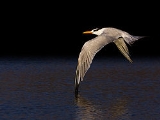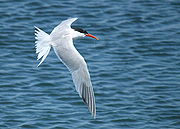
Elegant Tern
Encyclopedia
The Elegant Tern is a seabird
of the tern
family Sternidae. It breeds on the Pacific coasts of the southern USA and Mexico
and winters
south to Peru
, Ecuador
and Chile
.
This species breeds in very dense colonies on coasts and islands, including Montague Island (Mexico)
, and exceptionally inland on suitable large freshwater lakes close to the coast. It nests in a ground scrape and lays one to two eggs. Unlike some of the smaller white terns, it is not very aggressive toward potential predators, relying on the sheer density of the nests (often only 20–30 cm apart) and nesting close to other more aggressive species such as Heermann's Gull
s to avoid predation.
The Elegant Tern feeds by plunge-diving for fish, almost invariably from the sea, like most Thalasseus terns. It usually dives directly, and not from the "stepped-hover" favoured by the Arctic Tern
. The offering of fish by the male to the female is part of the courtship display.
Surprisingly, this Pacific species has wandered to western Europe
as a rare vagrant on a number of occasions, and has interbred with the Sandwich Tern in France
; there is also one record from Cape Town
, South Africa
in January 2006, the first record for Africa
.
 This is a medium-large tern, with a long, slender orange bill, pale grey upperparts and white underparts. Its legs are black. In winter, the forehead becomes white. Juvenile Elegant Terns have a scalier pale grey back. The call is a characteristic loud grating noise like a Sandwich Tern.
This is a medium-large tern, with a long, slender orange bill, pale grey upperparts and white underparts. Its legs are black. In winter, the forehead becomes white. Juvenile Elegant Terns have a scalier pale grey back. The call is a characteristic loud grating noise like a Sandwich Tern.
This bird could be confused with the Royal Tern
or Forster's Tern
, but the elegans is larger and thicker-billed and shows more white on the forehead in winter. Out of range, it can also be easily confused with the Lesser Crested Tern
. See also Orange-billed tern
, and the external link below.
Some useful points to separate it from other terns in this group:
Seabird
Seabirds are birds that have adapted to life within the marine environment. While seabirds vary greatly in lifestyle, behaviour and physiology, they often exhibit striking convergent evolution, as the same environmental problems and feeding niches have resulted in similar adaptations...
of the tern
Tern
Terns are seabirds in the family Sternidae, previously considered a subfamily of the gull family Laridae . They form a lineage with the gulls and skimmers which in turn is related to skuas and auks...
family Sternidae. It breeds on the Pacific coasts of the southern USA and Mexico
Mexico
The United Mexican States , commonly known as Mexico , is a federal constitutional republic in North America. It is bordered on the north by the United States; on the south and west by the Pacific Ocean; on the southeast by Guatemala, Belize, and the Caribbean Sea; and on the east by the Gulf of...
and winters
Bird migration
Bird migration is the regular seasonal journey undertaken by many species of birds. Bird movements include those made in response to changes in food availability, habitat or weather. Sometimes, journeys are not termed "true migration" because they are irregular or in only one direction...
south to Peru
Peru
Peru , officially the Republic of Peru , is a country in western South America. It is bordered on the north by Ecuador and Colombia, on the east by Brazil, on the southeast by Bolivia, on the south by Chile, and on the west by the Pacific Ocean....
, Ecuador
Ecuador
Ecuador , officially the Republic of Ecuador is a representative democratic republic in South America, bordered by Colombia on the north, Peru on the east and south, and by the Pacific Ocean to the west. It is one of only two countries in South America, along with Chile, that do not have a border...
and Chile
Chile
Chile ,officially the Republic of Chile , is a country in South America occupying a long, narrow coastal strip between the Andes mountains to the east and the Pacific Ocean to the west. It borders Peru to the north, Bolivia to the northeast, Argentina to the east, and the Drake Passage in the far...
.
This species breeds in very dense colonies on coasts and islands, including Montague Island (Mexico)
Montague Island (Mexico)
Montague Island, known in Spanish as Isla Montague, is an island at the mouth of the Colorado River in the municipality of Mexicali, Baja California, Mexico, and is part of the Colorado River Delta and part of a broader region called the Salton Trough...
, and exceptionally inland on suitable large freshwater lakes close to the coast. It nests in a ground scrape and lays one to two eggs. Unlike some of the smaller white terns, it is not very aggressive toward potential predators, relying on the sheer density of the nests (often only 20–30 cm apart) and nesting close to other more aggressive species such as Heermann's Gull
Heermann's Gull
The Heermann's Gull is a gull resident in the United States, Mexico and extreme southwestern British Columbia. Of the current population of about 150,000 pairs, 90% nest on the island of Isla Rasa off Baja California in the Gulf of California, with smaller colonies as far north as California and...
s to avoid predation.
The Elegant Tern feeds by plunge-diving for fish, almost invariably from the sea, like most Thalasseus terns. It usually dives directly, and not from the "stepped-hover" favoured by the Arctic Tern
Arctic Tern
The Arctic Tern is a seabird of the tern family Sternidae. This bird has a circumpolar breeding distribution covering the Arctic and sub-Arctic regions of Europe, Asia, and North America...
. The offering of fish by the male to the female is part of the courtship display.
Surprisingly, this Pacific species has wandered to western Europe
Europe
Europe is, by convention, one of the world's seven continents. Comprising the westernmost peninsula of Eurasia, Europe is generally 'divided' from Asia to its east by the watershed divides of the Ural and Caucasus Mountains, the Ural River, the Caspian and Black Seas, and the waterways connecting...
as a rare vagrant on a number of occasions, and has interbred with the Sandwich Tern in France
France
The French Republic , The French Republic , The French Republic , (commonly known as France , is a unitary semi-presidential republic in Western Europe with several overseas territories and islands located on other continents and in the Indian, Pacific, and Atlantic oceans. Metropolitan France...
; there is also one record from Cape Town
Cape Town
Cape Town is the second-most populous city in South Africa, and the provincial capital and primate city of the Western Cape. As the seat of the National Parliament, it is also the legislative capital of the country. It forms part of the City of Cape Town metropolitan municipality...
, South Africa
South Africa
The Republic of South Africa is a country in southern Africa. Located at the southern tip of Africa, it is divided into nine provinces, with of coastline on the Atlantic and Indian oceans...
in January 2006, the first record for Africa
Africa
Africa is the world's second largest and second most populous continent, after Asia. At about 30.2 million km² including adjacent islands, it covers 6% of the Earth's total surface area and 20.4% of the total land area...
.
Identification

This bird could be confused with the Royal Tern
Royal Tern
The Royal Tern is a seabird in the tern family Sternidae. This bird has two distinctive subspecies. T. m. maximus breeds on the Atlantic and Pacific coasts of the southern USA and Mexico into the Caribbean. The slightly smaller T. m. albididorsalis breeds in coastal west Africa...
or Forster's Tern
Forster's Tern
The Forster's Tern, Sterna forsteri, is a member of the tern family Sternidae. It breeds inland in North America and winters south to the Caribbean and northern South America....
, but the elegans is larger and thicker-billed and shows more white on the forehead in winter. Out of range, it can also be easily confused with the Lesser Crested Tern
Lesser Crested Tern
The Lesser Crested Tern is a seabird of the tern family Sternidae...
. See also Orange-billed tern
Orange-billed tern
Orange-billed tern is a name applied to a group of three large terns in the genus Thalasseus with orange bills, which are quite similar in appearance and often considered difficult to identify, namely:* Royal Tern, Thalasseus maximus...
, and the external link below.
Some useful points to separate it from other terns in this group:
- It is marginally paler above than the Lesser Crested Tern with a white (not grey) rump.
- It a slightly longer, more slender bill and the curve of the bill is different from Lesser Crested tern.
- The black of the crest the comes down from the crown extends through the eye, creating a small black "smudge" in front of the eye. On Royal Tern, the black crest stops at the eye.
- The crest is more shaggy than in Lesser Crested Tern.

